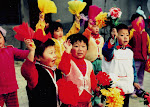 |
Chinese restaurant in
Nogales, Sonora, Mexico
|
When the
Chinese began immigrating around the world, many of them ended up in Mexico
where they became an important economic and social force to be reckoned with.
Many of them ended up in northwestern Mexico’s state of Sonora, which borders
the U.S. state of Arizona.
By the
early 20th century, Sonora was home to more Chinese than any other
state in Mexico. But that changed a few years later when thousands were
expelled from Sonora. The Chinese worked hard at local trade and businesses and
set mew demands in these fields, according to Evelyn Hu-De-Hart who wrote a
paper on the Chinese in northern Mexico.
Their
successes did not set well with the Mexicans, who felt they could not compete
with the industrious Chinese. Thus, the downfall of the Chinese began with the
Mexican Revolution of 1910 where new leaders promised the Mexican masses an end
to social injustices. The success and influences of the Chinese did not sit
well under the new regime, and eventually led to them being dispelled. The
Chinese never regained their influence.
In an
ironic twist, when the immigrants newly arrived in China, they sometimes only
found menial work that paid wages of about one-third of what Mexicans were
paid. This, again, did not sit well with the Mexicans who said this led to them
being exploited in the work place.
Some new
Chinese immigrants were bankrolled by long-time Chinese residents to start
their own businesses. This was usually something low on the totem pole, such as
street vending. But they quickly grew into larger businesses, perhaps in truck
farming, retail or manufacturing. At one time, the Chinese owned 10 of the shoe
factories in Sonora.





